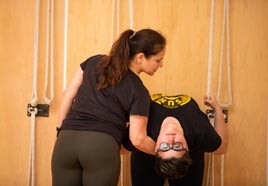The yoga path can build a foundation for happiness and emotional stability, and the journey is unique for each person.
A Certified Iyengar Yoga teacher can guide the class through demonstrations, verbal instructions and physical adjustments. We encourage students to ask questions and speak directly with the teacher about any interests or concerns.
Adjustments and physical touch are a part of the Iyengar Yoga method. While they can be extremely beneficial, adjustments are only helpful if the student wants them and is comfortable with the teacher. The yoga practice will be different each day and the student may, at any time, decide that they prefer not to be touched.

Our teachers require affirmative informed consent before they physically adjust anyone in class. This means that each student has the right to choose whether or not they wish to be adjusted in every class and with every pose. The teacher will ask for permission to adjust anyone. Unless the student consents or is in danger, the teacher will not touch them. After an understanding has been developed between the teacher and student over a period of time, consent may not be required prior to each adjustment. However, consent may be withdrawn at any time.
If your teacher does not respect your preferences, or if you feel violated in any way, please speak with a teacher, Institute staff member or member of the Management Team (institute@iyila.org). You may also email the IYALA Board President (president@iyila.org) or the IYALA Compliance and Ethics Committee (ethics@iyila.org).
The Iyengar Yoga community has a zero-tolerance policy towards abuse of any kind, be it verbal or through touch. It is our priority to respect the safety, dignity and autonomy of our students. All Certified Iyengar Yoga Teachers commit to following ethical standards outlined by IYNAUS. These standards include appropriate physical adjustments as well as appropriate relationships between teacher and student.
